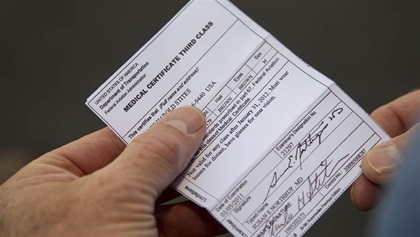Medical certification options: Fit to fly?
What you must know about medical certification

Pilots who exercise airline transport pilot (ATP) privileges—airline and certain other professional pilots—require a first class medical, valid for ATP privileges for six calendar months for pilots age 40 and over. If under 40, the first class is valid for 12 months.
Pilots flying commercially—charter flights, crop dusting, and similar activities—must have a second class medical, valid for commercial privileges for 12 months.
Private and recreational pilots—flying for pleasure or personal business, but not for hire—need only a third class medical. This certificate is valid for 24 months for holders over age 40, and 60 months if 40 or younger.
Before soloing, a student pilot must obtain a third class medical certificate from a designated AME. Students who aspire to fly professionally should consider obtaining a first class medical instead, to ensure there’s no unforeseen health issue that might prevent them from landing that airline job. After obtaining an initial FAA medical certificate, most private pilots have the option of transitioning to BasicMed, a simpler process requiring a physical exam at least every 48 months by any state-licensed physician.
Perfect vision is not required, although you must be able to see 20/20 or better in each eye, with or without correction, for a first or second class medical; 20/40 or better in each eye for third class.
There are 15 specific disqualifying conditions, including severe personality disorder, psychosis, substance dependence/abuse, epilepsy, and a variety of heart conditions (myocardial infarction, angina pectoris, coronary heart disease, cardiac valve replacement, permanent cardiac pacemaker implant, or heart replacement). However, even some of these can qualify for medical certification if health has improved and enough time has passed. Under some circumstances strokes and “ministrokes” can be reconsidered after one to two years of recovery. And recent FAA rule changes have made it possible for people with insulin-treated diabetes to qualify for commercial flying opportunities.
Many young people have been diagnosed with attention deficit hyperactivity disorder (ADHD), previously called attention deficit disorder (ADD), or been treated for associated symptoms without a diagnosis. If an applicant for medical certification has been diagnosed with this condition or is taking one of the medications used to treat it, the FAA requires an extensive evaluation. Any medications must be discontinued for at least 90 days before a neuropsychological evaluation with a clinical psychologist or neuropsychologist. If the individual really does have ADHD as determined by the evaluation, medical certification is less likely.
The FAA can deny a medical certificate to anyone with an established history of substance dependence or abuse. Even a single alcohol-related motor vehicle conviction in one’s driving history could negatively affect an application for a medical certificate. A history of multiple DUI/DWIs further complicates the process. You will be asked to provide extensive additional information about your past and current use of alcohol.
Once you have a medical certificate, you’re responsible for monitoring your health and temporarily grounding yourself when you’re under the weather. Sinus congestion on the ground can become a debilitating headache if you hop in an airplane and climb several thousand feet.
AOPA employs a team of medical certification specialists to help pilots through the certification process, which can be complicated. If you’re concerned about a condition or have questions, call them at 800-USA-AOPA (872-2672) or visit aopa.org.
| Medical Certificate | First Class | Second Class | Third Class |
| Type of flying | Airline Transport | Commercial | Private, student, recreational |
| Duration | 6 months if age 40 or older; 12 months if under age 40 | 12 months | 2 years if age 40 or older; 5 years if less than 40 at exam |
| Distant vision | 20/20 in each eye, with or without glasses/contacts | 20/40 in each eye with or without glasses/contacts | |
| Near vision | 20/40 in each eye, with or without glasses/contacts | ||
| Color vision | Colors necessary for safe performance of airman duties | ||
| Hearing | Conversational voice at 6 feet with both ears, or audiometry | ||

 Before your first visit
Before your first visit

